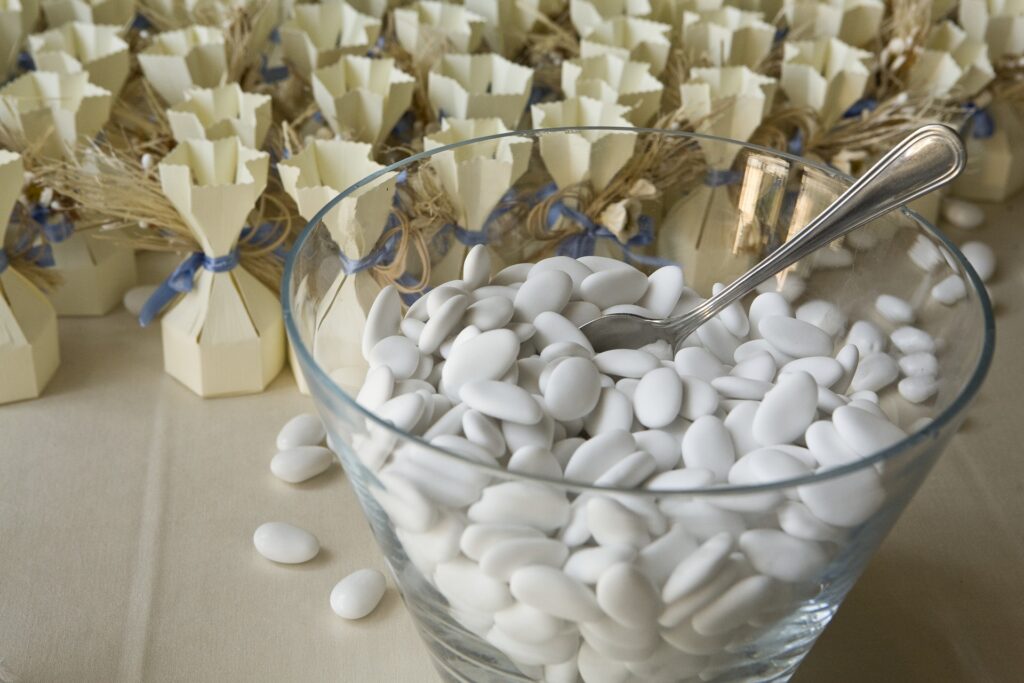If you have ever been a guest at an Italian wedding (or other celebratory event) you will have seen sugared almonds known as Confetti or Jordan Almonds. These confections are a ceremonial staple typically handed out as a bomboniera (party favour). They are a symbolic and commemorative gift with the occasion typically dictating their hue. Blue and pink for baptism, red for graduation and confirmation, green for engagement, white for wedding, communion and confirmation, silver for 25th anniversary and gold for 50th anniversary.
Confetti are almonds with a hard sugar coating whose history dates back to the Romans, who used them to celebrate unions and births. Their name derives from the Latin confectum meaning prepared or wrapped.
The first confetti were made with honey and later adopted the thin layers of sugar with the introduction of the sugarcane in the 15th Century by the Arabs. Fresh almonds have a bittersweet taste which represents life, and the sugar coating is added with the hope that married life will be more sweet than bitter. Newlyweds were often showered with the candied almonds as well-wishes. The tradition has since evolved, confetti of the paper kind is tossed at the wedding couple and the almonds are either wrapped in tulle, boxed, or fashioned into silk or organza flowers and handed out. The one element that remains the same however is the number of almonds that is gifted, always an odd number which is considered lucky because odd numbers are indivisible and should therefore augur that the newlyweds share everything and remain undivided. The number typically handed out is five to represent health, wealth, fertility, happiness, and longevity.

Confetti di Sulmona
The most renowned confetti are the ones produced in the town of Sulmona in Abruzzo. The art of confetti making is said to have begun in the 15th Century by the local Sulmona nuns of Santa Chiara. The sisters were the city’s chief sweet makers, working the individual confetti into rosaries, flowers, grapes, and wheat to name just a few and in affect building the city’s fame in the newly emerged sugar trade. The craft was then industrialized by the Pelino family in 1783. The centuries old and famed factory continues to create these incomparable confections in the traditional method, made through a four-day process.
The artisan production begins with choosing the finest Sicilian almonds (from Avola, in the province of Siracusa) which are peeled and then covered in sugar without the addition of any starch that would affect their delicate flavour and make them heavier (to test if you are in fact eating true Confetti di Sulmona, place the sugared almond in a glass full of water. If the water becomes cloudy, it means that starch is present as a sugared almond without starch leaves the water clear); then they rest to dry. It is a labour of love that requires much attention to detail which is perhaps why the Pelino confetti are the confection of choice for the Royals (they were used to celebrate the weddings of Charles and Diana, William and Kate, and Harry and Meghan).
While the Confetti from Sulmona do not hold an EU designation, they have been recognized as a PAT (Prodotto Agroalimentare Tradizionale) product by the Italian Ministry of Agricultural, Food and Forestry Policies, including them on its list of traditional Italian agri-food products.
Sulmona has been dubbed the capital of sugar-coated almonds and a stroll through its scenic streets confirms this. The roads are almost paved in confetti, lined with bouquets in traditional forms but also variations including those with pistachios, hazelnuts, fruits, or chocolate instead of almonds. In addition, the famed confetti can be enjoyed in every flavour imaginable, limoncello, tiramisu, ricotta, and pear, frutti di bosco, hazelnut and many more. There is also a museum dedicated to this celebrated treat where visitors can see a wide display of old-fashioned confectionery machines and equipment, memorabilia and precious, rare objects relating to this ancient Sulmonese art.




Add a comment